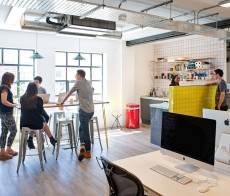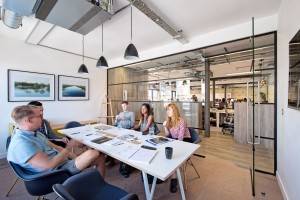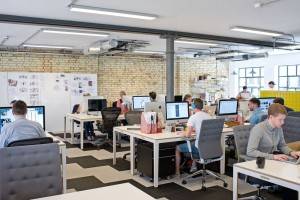 When it comes to the incorporation of branding and identity into a workplace, there is a simple option, which is to produce a design that faithfully incorporates the firm’s logos, colours and straplines in the interior. There’s nothing wrong with this, except for the fact that it is literally superficial and so may miss the opportunity to create an office design that scratches beneath the surface to reveal what lies beneath. When you get past the layers of branding and identity, you uncover something that we call culture. This can take things to a whole new level because the challenge becomes how to create a workplace design that communicates and fosters both the identity and the culture of the organisation. The benefits to the organisation can be enormous, not least because this approach bridges a number of disciplines such as human resources and office design and so drives a number of strategic objectives.
When it comes to the incorporation of branding and identity into a workplace, there is a simple option, which is to produce a design that faithfully incorporates the firm’s logos, colours and straplines in the interior. There’s nothing wrong with this, except for the fact that it is literally superficial and so may miss the opportunity to create an office design that scratches beneath the surface to reveal what lies beneath. When you get past the layers of branding and identity, you uncover something that we call culture. This can take things to a whole new level because the challenge becomes how to create a workplace design that communicates and fosters both the identity and the culture of the organisation. The benefits to the organisation can be enormous, not least because this approach bridges a number of disciplines such as human resources and office design and so drives a number of strategic objectives.
One of the most obvious examples of this is with the issue of employer branding, a subject that from a human resources perspective at least is about both the recruitment and retention of staff as well as the creation of a universally understood working culture, a subject that is of growing interest to organisations as they adopt more agile working practices.
A multi-faceted challenge
 Of course, the issue of how to convey organisational culture and identity is complex, multi-faceted, fast moving and demands a multi-disciplinary approach. It is certainly likely to require input from HR and IT and will attract the interest of managers across the organisation. It incorporates a wide range of factors from working culture, working methods, interior design, technology and the physical environment.
Of course, the issue of how to convey organisational culture and identity is complex, multi-faceted, fast moving and demands a multi-disciplinary approach. It is certainly likely to require input from HR and IT and will attract the interest of managers across the organisation. It incorporates a wide range of factors from working culture, working methods, interior design, technology and the physical environment.
Addressing all of these cultural issues is all inherently good for the business and there’s growing evidence to suggest that a clear focus on culture is important to the outside world too, including investors. A study published this month by investment analysts Stamford, found that 75 percent of 1,000 investors surveyed believe that culture plays a major role in their valuations of businesses, while 60 percent claim to have had a personal experience of an investment decision that was positively or adversely impacted by culture.
Moving beyond branding
So whereas branding the workplace may once have focussed on replicating a corporate identity, there is now a far greater focus on reflecting culture and values to staff, clients and other stakeholders. Where once you had logos in the carpet, we now have visualisations of how the company addresses business and environmental issues, the intelligent use of colours and materials to convey ideas and emotions, cultural imagery and manifestations of the outside world.
For workplace designers, this all represents a twofold challenge. Firstly they must understand the culture of the organisation and secondly they must find a way of conveying it in the spaces they help to create. The complicating factor is that while many facets of a culture may be relatively fixed and easy to pin down, others are likely to be more susceptible to change.
A multi-faceted solution
 Developing an understanding of a business’s culture cannot happen unless there is a great deal of trust between the designer and client combined with the capability of the designer to ask the right questions, listen carefully, observe minutely and gather information from a number of sources. This is not simply a matter of taking a brief then responding to create the physical embodiment of an organogram overlaid with manifestations of the firm’s mission statement and values.
Developing an understanding of a business’s culture cannot happen unless there is a great deal of trust between the designer and client combined with the capability of the designer to ask the right questions, listen carefully, observe minutely and gather information from a number of sources. This is not simply a matter of taking a brief then responding to create the physical embodiment of an organogram overlaid with manifestations of the firm’s mission statement and values.
It is also about understanding how the firm is perceived and wants to be perceived, how information and ideas flow and develop, how the workplace fosters creativity, how individuals relate to work and how they find the balance between work and their personal wellbeing. It is about understanding how technology integrates with both the physical environment and the firm’s processes and channels of communication. It is about understanding how the firm wants its working environment to serve visitors as well as employees. It is about all this and more.
How this is then translated into a workplace design that is unique to the organisation is down to the ability, creativity and experience of the designer. We are fortunate these days to be able to draw on a wide range of working models, interior elements and technologies that free designers to create genuinely tailored solutions. The days when the choices were generally limited to either open plan or cellular office design are long behind us, and we are now able to apply a variety of work settings and working methodologies which, when combined with the right branding and identity, create a that reflects and supports the firm’s culture.
_______________________________________
 Gary Chandler is the Managing Director of office design and fit-out firm Area Sq.
Gary Chandler is the Managing Director of office design and fit-out firm Area Sq.














July 28, 2015
Beyond branding – how workplace design can express a firm’s culture
by Gary Chandler • Comment, Facilities management, Workplace, Workplace design
One of the most obvious examples of this is with the issue of employer branding, a subject that from a human resources perspective at least is about both the recruitment and retention of staff as well as the creation of a universally understood working culture, a subject that is of growing interest to organisations as they adopt more agile working practices.
A multi-faceted challenge
Addressing all of these cultural issues is all inherently good for the business and there’s growing evidence to suggest that a clear focus on culture is important to the outside world too, including investors. A study published this month by investment analysts Stamford, found that 75 percent of 1,000 investors surveyed believe that culture plays a major role in their valuations of businesses, while 60 percent claim to have had a personal experience of an investment decision that was positively or adversely impacted by culture.
Moving beyond branding
So whereas branding the workplace may once have focussed on replicating a corporate identity, there is now a far greater focus on reflecting culture and values to staff, clients and other stakeholders. Where once you had logos in the carpet, we now have visualisations of how the company addresses business and environmental issues, the intelligent use of colours and materials to convey ideas and emotions, cultural imagery and manifestations of the outside world.
For workplace designers, this all represents a twofold challenge. Firstly they must understand the culture of the organisation and secondly they must find a way of conveying it in the spaces they help to create. The complicating factor is that while many facets of a culture may be relatively fixed and easy to pin down, others are likely to be more susceptible to change.
A multi-faceted solution
It is also about understanding how the firm is perceived and wants to be perceived, how information and ideas flow and develop, how the workplace fosters creativity, how individuals relate to work and how they find the balance between work and their personal wellbeing. It is about understanding how technology integrates with both the physical environment and the firm’s processes and channels of communication. It is about understanding how the firm wants its working environment to serve visitors as well as employees. It is about all this and more.
How this is then translated into a workplace design that is unique to the organisation is down to the ability, creativity and experience of the designer. We are fortunate these days to be able to draw on a wide range of working models, interior elements and technologies that free designers to create genuinely tailored solutions. The days when the choices were generally limited to either open plan or cellular office design are long behind us, and we are now able to apply a variety of work settings and working methodologies which, when combined with the right branding and identity, create a that reflects and supports the firm’s culture.
_______________________________________